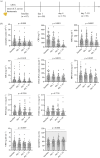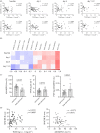Peptidylarginine deiminase 4 and ADAMTS13 activity in Staphylococcus aureus bacteraemia
- PMID: 37778390
- PMCID: PMC10542450
- DOI: 10.1098/rstb.2023.0042
Peptidylarginine deiminase 4 and ADAMTS13 activity in Staphylococcus aureus bacteraemia
Abstract
Staphylococcus aureus infection is associated with increased levels of neutrophil extracellular traps (NETs) and von Willebrand factor (VWF), and with reduced activity of ADAMTS13 (a disintegrin and metalloproteinase with thrombospondin type 1 motifs, member 13). Peptidylarginine deiminase 4 (PAD4) contributes to NET formation and inactivates ADAMTS13 in vitro. The role of PADs in the dynamics of NETs, VWF and ADAMTS13 has not yet been studied. We thus aimed to assess the longitudinal evolution of NETs, PADs, VWF and ADAMTS13 activity in S. aureus infection. Plasma samples from S. aureus bacteraemia patients were longitudinally collected and analysed for NETs, PAD4/PAD2, VWF and ADAMTS13 activity. Correlation analyses with clinical data were performed. Recombinant PAD4 and S. aureus were assessed in vitro for their potential to modulate ADAMTS13 activity. Sixty-seven patients were included. Plasma levels of NETs, VWF, PAD4 and PAD2 were increased and ADAMTS13 activity was decreased. Levels of PADs were negatively correlated with ADAMTS13 activity. NETs were positively correlated with PADs, and negatively with ADAMTS13 activity. In vitro, recombinant PAD4 but not S. aureus reduced ADAMTS13 activity in plasma. Levels of PAD4 and PAD2 correlate with reduced ADAMTS13 activity, with neutrophils as the likely source of PAD activity in S. aureus bacteraemia. This article is part of the Theo Murphy meeting issue 'The virtues and vices of protein citrullination'.
Keywords: ADAMTS13; Staphylococcus aureus; neutrophil extracellular traps; peptidylarginine deiminase 4; von Willebrand factor.
Conflict of interest statement
C.P.M. is a fellow of the Fonds Wetenschappelijk Onderzoek (FWO, 11B0621N). T.V. and P.V. are Senior Clinical research fellows of the FWO. K.M. is an inventor of the granted patent US9642822 awarded to Children's Medical Center Corporation covering the targeting of NETs in thrombosis and lung injury. The other authors declare no conflict of interest.
Figures




References
Publication types
MeSH terms
Substances
Associated data
LinkOut - more resources
Full Text Sources
Medical
Miscellaneous
